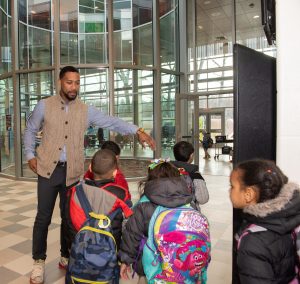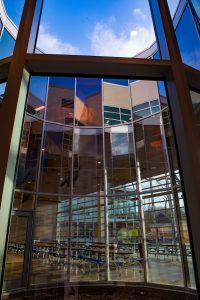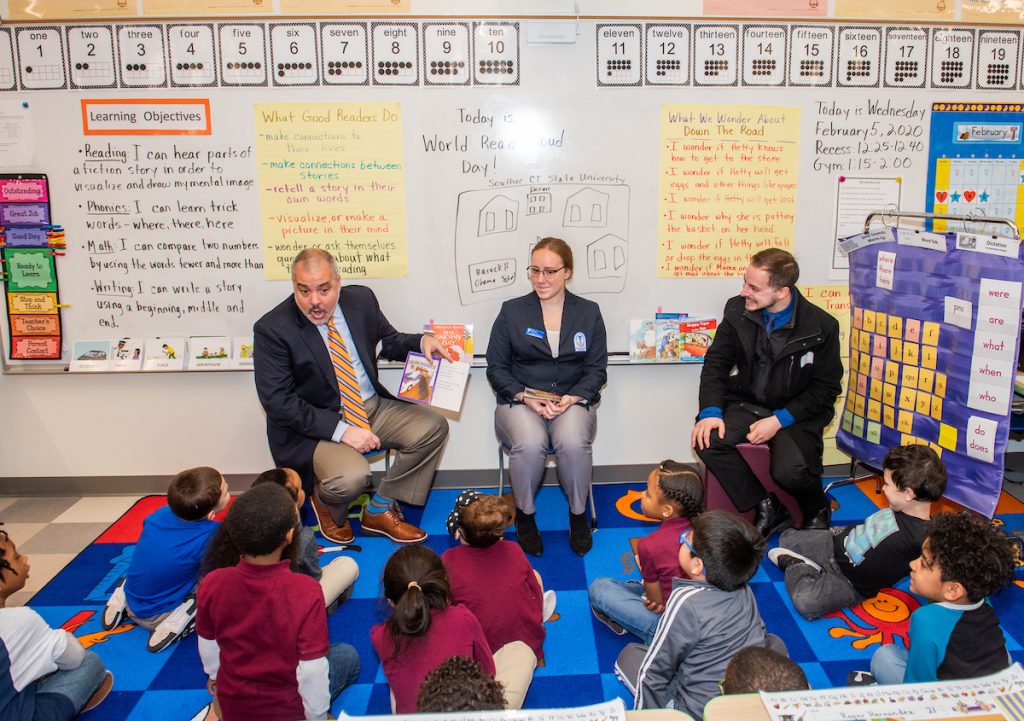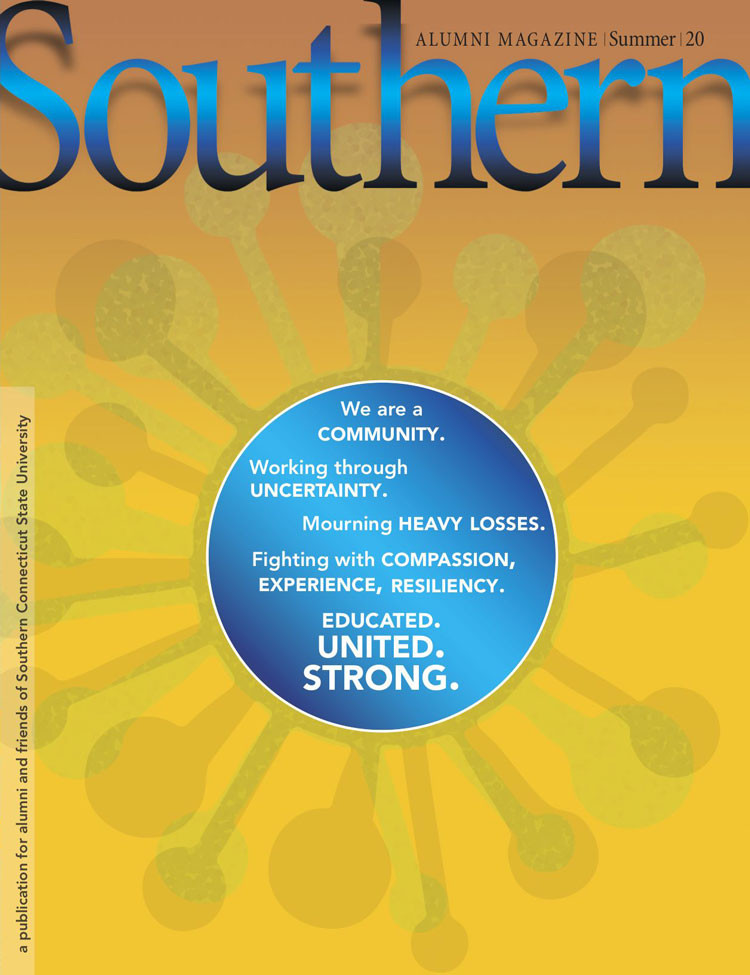Designed with the latest educational advances in mind, the Barack H. Obama Magnet University School opened on Southern’s campus on Jan. 7. By March 13, both the Obama School and the university had temporarily shuttered their buildings and were moving to remote/online learning in response to New Haven Mayor Justin Elicker’s call for citywide closures to curb the COVID-19 pandemic. (Campus is opening for the fall 2020 semester.) But while students — both elementary age and Southern education majors — had worked in the new building for only a few months, the potential had already been demonstrated, and it’s a win-win for all involved.
For Southern students, the Obama School provides an opportunity for all-important experiential learning. The elementary school’s students and their teachers, in turn, benefit through additional support in the classroom from student-teachers and field workers — as well as the experience of Southern’s staff and faculty. An over-arching goal: to serve as a national model, highlighting best practices and promoting educational innovation.
The new elementary school is a collaboration between Southern, the New Haven Board of Education, and the city of New Haven. As such, it is a rarity — uniting a public university with a public school system.

“A lot of times, the schools found on college campuses are private enterprises, so they are selective. You pay tuition to go. The faculty’s kids attend,” says Stephen Hegedus, dean of the College of Education. In contrast, the Obama School is part of New Haven Public Schools, a magnet program that accepts students from regional school districts but primarily serves New Haven. The Obama School is designed to educate close to 500 students. It opened with classrooms for kindergarten through fourth grade. Looking forward, three preschool classrooms will be added, bringing 60 three- and four-year-old children into the fold.
“Part of our social justice mission is to create access for all kids. It just makes sense to me for the Obama School to have this connection with Southern, a public university in New Haven that has had a 100-plus-year mission dedicated to teacher and educator preparation of the highest-quality,” says Hegedus.
The Obama School — formerly known as the Strong 21st Century Communications Magnet — has evolved dramatically over many years. About six years ago, aided by grant funding, it became a magnet school with an educational focus on communications, technology, and STEM (science, technology, engineering, and mathematics). Students receive instruction in Chinese and American Sign Language — and the elementary school was named a “School of Distinction” by EdSight.CT.gov for 2018-19, the most recently available data.
“With our technology, we’ve been able to open up the world to the kids,” says Susan DeNicola, ’86, M.S. ’90, 6th Yr. ’99, principal of the school for the past nine years.
But while the curriculum changed, the school, which had moved numerous times, was still located in an old building on Grand Avenue. It was welcoming and homey, teachers say. But there were serious issues. The building, situated on four streets, had a roof plagued with leaks. The playground was dilapidated, too dangerous for the children to use. Most-often mentioned: a lack of natural light. “In the other building we had very few windows — and what windows we did have were clouded up, so the kids could not see out. We had no ideas if it was pouring,” says DeNicola. “We had no idea if there was a hurricane.”
Now located on campus at 69 Farnham Ave., the Obama School is designed so sunlight streams into all interior spaces. A multistory, outside STEM room is lined with windows to stream light into the interior, including the cafeteria. Most classrooms are situated to provide views of West Rock and the surrounding forest of 200-plus-year-old trees. Cozy, built-in seating is located outside of classrooms, providing an ideal spot for tutors to work with students who might need additional support. There are dedicated music and art rooms as well as a STEM resource laboratory.

A sensory room houses a ball pit, trampoline, and other activities, for students who need a physical outlet or support. There is a gym with basketball hoops — and an age-appropriate playground is adjacent to an outside STEM classroom with space for growing plants.
The building also is designed with Southern students and faculty in mind. A centrally located Faculty Innovation Lab visually demonstrates the school’s focus on teacher preparation. “I think of the school as a course textbook in a lot of ways,” says Laura Bower-Phipps, professor of curriculum and learning at Southern. In addition to inviting her students to tour the building, Bower- Phipps teaches a course — “Responsive Curriculum and Assessment” — in the Faculty Innovation Lab space. In the spring 2020 semester prior to the shift to online learning, 16 Southern students were placed at the Obama School: six were student-teachers and 10 were completing field experiences, the final step before taking a student-teacher assignment.
The partnership extends to Southern’s Center of Excellence on Autism Spectrum Disorders. “They have helped us out quite a bit. Training our teachers and bringing support to the school,” says DeNicola. The Obama School has two self-contained classrooms for students who are on the autism spectrum, serving up to 24 students. The collaboration between Southern’s Center of Excellence and New Haven Public Schools was established years ago by the center’s cofounder and former director, Ruth Eren. Services include professional- development opportunities for teachers, support-service providers, and paraprofessional as well as training and information sessions for parents and caregivers. “Our center team and the larger college community are eager to continue this collaboration, and excited about the myriad possibilities that exist for ongoing, bidirectional learning,” notes Kari Sassu, 6th Yr. ’15, associate professor of counseling and school psychology, and director of strategic initiatives at the center.
Hegedus concurs: “Having a presence there is important not only to help the teachers and the families but also to try to advance our overall knowledge of helping students who are on the spectrum.”

These and similar goals have the educators at Southern and the Obama School eagerly looking to the future and students’ return to campus. Like their peers, fourth grade teacher Kayla Seeley, ’12, M.S. ’17, and second grade teacher Karissa L. O’Keefe, ’04, M.S. ’13, have thoughts about potential initiatives. Among their vision: Mentoring visits from Southern athletics teams. Collaborations with the Department of Communications Disorders. Halloween trick-or-treating on campus. Visits to Buley Library, the new science building, and the Lyman Center for the Performing Arts. Both stress the importance of showcasing college as the future to their young charges.
Principal DeNicola looks to the future as well: “We hope to really utilize campus, so our students get the most benefits . . . and we want to involve our student-teachers to the point that they feel like this [points around the school] is home. We want to be the teaching school. The school that teaches teachers.” ■



